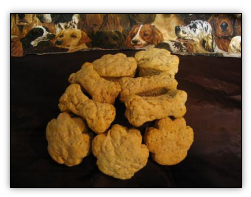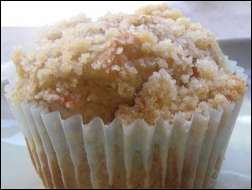|

2 1/2 teaspoons dry yeast
1/4 cup lukewarm water
1 egg
3/4 cup chicken broth 1/4 cup
honey
2 tablespoons minced garlic
3 cups whole wheat flour
1 cup cracked wheat
Directions:
Preheat oven to 325 ° F
(165 ° C). In
a large bowl,dissolve yeast in water. Add egg, broth, honey, and
garlic. Gradually blend in the flour and cracked wheat. Add enough
wheat flour to form a stiff dough.
Transfer to a floured surface
and knead until smooth (about 3-5
minutes). Shape the dough into a ball and roll to 1/4-inch (6 mm)
thick. Using bone-shaped cookie cutters, cut out biscuits. Place on
ungreased baking sheets, spacing them about 1/4-inch (6 mm) apart.
Gather up the scraps, roll out again, and cut additional biscuits.
Bake for 45 minutes. Let cool
overnight. Makes several dozen biscuits that freeze well.
|

[Clicl
on the images to inlarge]
1. The first official step in every image you do should be similar to
this, especially if you are drawing something you have never done
before. This crucial step of course is research; go to the zoo, look up
images on free stock sites, borrow books from your local library. Why
do we do this? To learn the basic shapes of the animal you are seeking
to draw, as illustrated above. Some tips depending on media; Pencil and
Paper folks, remember to draw lightly so you can erase the initial
sketch. Digital Folks, remember layers and different colors are your
friends.
2. The body: Draw a circle for the chest, the stomach and back are
comprised of an oval, as is the rump. See image above if you are having
troubles.
3. The extremities: Start by drawing lines to represent the position
and structure of the legs(see 3a). Afterwards flesh out the legs with
your basic shapes. I used Ovals of
|
various
sizes, squares and rectangles(see 3b). The head and neck are
generally drawn last as it personally helps me keep it in proportion to
the body. I used triangles, a square and rectangle for this part of the
step. Remember when drawing the muzzle the upper and lower jaw remain
parallel even when howling.
4. Fleshing out: Digital users, this is where you make a new layer.
Start to flesh out your sketch, give it substance and detail. Thicken
up the neck, add in eyes, nose, mouth, etc (see 4a). After the initial
fleshing, go over it again and add in even more detail, such as fur
tuffs and muscle lines. Traditional users, here is where you decide if
you are going to leave it as a sketch or ink it. Digital users, set
your two current layers to around 50% opacity to lighten up the image
in preparation for inking.
5. Final production: Digital users, make yet another layer. Proceed to
ink your image in your preferred method. For traditional I prefer pens
that have waterproof and fade proof ink. Digitally I use a 3px brush as
I prefer finer lines on my artwork. Once inked traditional users can
erase the pencil lines after the ink dries, digital users can hide or
delete their two previous layers. Don't forget to sign your artwork and
move on to coloring in your preferred method! |
|
|

STORY BY DRMCHASER |

WRITTEN
BY KHOLRAN |
|
|
One of the most beautiful of
the large cats is the Snow Leopard but they are endangered and in
danger of becoming extinct.
The snow leopard is a rare
and secretive animal that inhabits a harsh,
remote environment in the mountains of Central Asia, they are a rare
sight, with only about 6,000 left in the wild. They have thick fur
which insulates them from the snow and the cold, and wide, fur-covered
feet which act as natural snow shoes.
These powerful predators can
kill animals three times their weight such
as the blue sheep (bharal) of Tibet and the Himalayas and Mountain Ibex
found over most of the rest of their range. However they also eat
smaller animals such as marmots, hares and game birds. Snow Leopards
also sometimes have a taste for domestic animals, which has led to many
deaths of the big cats at the hands of herders who often retaliate for
these losses by trapping, poisoning, or shooting snow leopards.
These endangered cats are on
a drastic decline because they are being
hunted for their beautiful fur and their organs, which are used in
traditional Chinese medicine. Vanishing habitat and the decline of the
cats' large mammal prey are also contributing factors. As humans move
into the mountainous areas with their livestock, the snow leopard's
habitat is being pushed back further and further. The livestock
overgrazes the mountain grasslands which damages the already fragile
lands leaving less food for the wild sheep and goats that are the main
prey of the Snow Leopard. The prey populations are also being depleted
by legal and illegal hunting for meat and trophies.
Males and females are
together for only a short time during the mating
season and males are not involved with cub rearing. Female Snow
Leopards in the wild have their cubs in June or July, usually 2 or 3
cubs are born in a litter. In captivity, they have been known to have
up to 7 cubs at a time but in the wild, it might be hard to
successfully raise more than 2 or 3 cubs because of the difficulty of
feeding them.
It is not known exactly how
many snow leopards exist in the wild
because the species is very difficult to study and count because of
their elusive, solitary nature and the remoteness of its habitat,
scientists must often rely on indirect methods to estimate population
sizes.
It is also not known how many
Snow Leopards there were in the past, but
they have already disappeared from parts of Mongolia where it used to
live. The number of snow leopards in the Kyrgyz Republic, has recently
declined due to excessive poaching.
|

Photo by National Geographic
Other large and small
wold cats on the endangered list include the
Ocelot, Jaguarundi, Jaguar, Cougars, Lions, Leopards including the Amur
(Closest to Extinction), Northern Chinese, Black, Clouded and the
Persian Leopards, Geoffroy's Cat, Margay, Manul (Pallas's Cat), Fishing
Cat, Jungle Cat, Serval and Barbary Serval, Caracal, Bobcat, Lynx
including the Canadian, Spanish, American and Eurasian Lynx, Asian
Leopard Cat, Marbled Cat, Black-footed cat, Sand cat, Pampas cat,
Flat-headed cat, Kodkod, Bay cat, Andean mountain cat, Asian golden cat
and Chinese mountain cat. The worlds tiger population has dropped from
over 100,000 to under 10,000 in the last century. Today there are only
five subspecies of tigers left. The Bali Tiger, Caspian Tiger, and
Javan Tiger have already become extinct.
Thanks to the hard work
and research done by wildlife conservationists,
many of these cats could make a slow but important comeback. There are
many organizations out there dedicated to the conservation of wild
animals. Most of these accept donations to help with the rehab
projects.
Some of these organizations include:
http://wwf.com
www.felidaefund.org
www.cathouse-fcc.org
http://www.pawsweb.org
www.felineconservation.org
www.bigcatrescue.org/index.htm
http://members.aol.com/cattrust/index.htm
In doing the research for this article, I have discovered cats that I
didn't even know existed. I found this to be very interesting and I am
amazed at all the different wild cat species there are in this world.
Ingredients
3/4 cup oatmeal
1/3 cup molasses
1/2 cup water
3/4 cup flour
3/4 cup bran
1/2 cup brown sugar
1 apple
2 carrots
Directions
1. preheat oven to 400 degrees
2. grease muffin tin
3. shred apple and carrots
4. mix apple and carrots with molasses
5. add brown sugar, water, flour and oatmeal
6. scoop dough into muffin tin and sprinkle each muffin with brown
sugar
7. bake for 30 to 45 minutes
|
For humans, winter means ice skating, skiing, building snowmen, and
making snow angels. For pets, the arrival of cold weather can have a
very different meaning. Winter can be a very dangerous time for pets,
but fortunately, there are steps we as owners can take to ensure our
four-legged companions stay safe.
Bring pets indoors
whenever possible when the temperature drops below
freezing. Just because an animal has a fur coat doesn’t mean it is
immune to the dangers of low temperatures. Cats and dogs can suffer
hypothermia and frostbite when left exposed to the elements, and if
they are permitted to roam, are at risk of falling through snow-covered
ice into ponds, swimming pools, lakes, streams, or other water bodies.
Certain dog breeds, such as Huskies, Chows, and Malamutes, have been
bred to withstand frigid temperatures and may be better able to spend
longer periods of time outdoors, but the vast majority of dogs cannot
handle extreme cold. Young animals, senior animals, and
immuno-suppressed pets (such as cats affected with FIV) are more at
risk from temperature dangers than healthy adults. For the vast
majority of pets, if it‘s too cold for you to spend extended periods of
time outside, it‘s too cold for your pets.

Keep pets away from
antifreeze and de-icers. Antifreeze tastes sweet,
and can be very tempting, especially to a thirsty cat or dog, but it is
often fatal even in very small amounts. Clean up any spills in the
garage or driveway, and ensure that all containers are secure and well
out of reach of pets. Sidewalk de-icers can present similar problems if
ingested, as well as causing irritation to paw pads. Be sure to clean
your pet’s feet with a warm, damp cloth after going for a walk or
spending any time outdoors.
Outdoor cats, both
owned and stray, will occasionally seek shelter
under the hoods of cars and trucks. The engine provides warmth and
protection from wind, and a recently-parked car makes a cozy sleeping
spot. If there are outdoor cats in the area, be sure to bang on the
hood of the car to wake them up and scare them off before starting the
engine. A moving fan belt can severely injure, maim, or kill an
unsuspecting cat or kitten.
As with any other time
of year, inside the house is the only truly safe
place for pet cats and dogs to spend their time. However, by keeping
these things in mind, we can ensure that their time spent outdoors is
not hazardous to their health. Prevent tragedy this winter and keep
your pets out of danger. |
|
|
 |
|
|

















